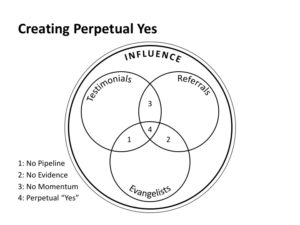While testimonials are static statements for a job well done, a referral is an introduction to another potential client or customer. One person says to another, “You should really talk to Tom. He did terrific work on our project, and he might be able to help you.”
The next best thing to someone witnessing your outstanding performance is a trusted colleague telling someone else about that outstanding performance. Call them referrals, call them introductions, call them networking opportunities. Whatever. Just take advantage of them.
Referrals will help your persuasion efforts because they provide a “warm” contact in your target. You’re a friend-of-a-friend, a welcome visitor, a known entity. This offers instant credibility and removes the time and effort required to “prove” yourself and your credentials or ideas. Your target is immediately and seamlessly involved.
Referral Reluctance
Yet, like testimonials, many people don’t leverage referrals. I call it “referral reluctance.”
They don’t want to imperil a new relationship and are more concerned with being liked than being respected, with gaining affiliation instead of gaining an objective.
They also don’t want to sound like a sales-person. They feel, inexplicably, that they are asking for something instead of contributing something, trying to take instead of give. Sometimes, people feel as though they will put the other person in an awkward position. In those cases, their sympathy outweighs their empathy.
Referral Deferral
On the other hand, there also exists a phenomenon called “referral deferral,” whereby your persuaded target doesn’t want to sound as though he is pushing your business toward others. In some cases, that target might have been “burned” before when making what turned out to be a bad referral to a friend. Or perhaps, people don’t like when they are put in a similar position.
Other possible reasons for referral deferral include not wanting others to think they are part of a manipulative action, don’t know what to say, have a lack of trust or simply possess an innate cynicism that precludes them from reaching out to colleagues and peers.
Ask for the Referral
You can help overcome referral reluctance and referral deferral by establishing a good rapport early on. Securing referrals and introductions shouldn’t be an ambush. If you’re working with someone on a project and think you’d like to leverage that person for future referrals and introductions, simply say something like, “My objective is to make you so deliriously happy that you’ll want to tell others about our great work.”
This will make you memorable, because a lot of people don’t make such bold statements too often. “Deliriously happy” is compelling language, like Babe Ruth calling his shot.
I like to end these kind of conversations with a quick confirming question: “Fair enough?” “Sound good?” Now, your target has gone on record and will be more inclined to follow through on that referral, because he promised he would.
Timing, in business and just about anything else, is everything. Some moments are better than others when asking for a referral. You don’t want to ask too early in the project, because you may not have delivered or begun to show results yet. That would be like proposing marriage on a blind date. You also don’t want to wait too long, because, no matter how well you’ve performed on an assignment, enthusiasm cools and memory fades.
The two best times?
- During your project when your target has made a significant positive comment, such as “Working with you is so easy!” Now, that is an opportune time, because I have never seen a project go completely smoothly all the time. There always seems to be a midcourse correction required or a misunderstanding or argument at some point during the process. So take advantage of propitious moments when you can.
- When your target has indicated excitement and you sense you can capitalize on it. This might be during your project wrap-up, while reviewing positive results or when you hear such trigger terms as “excellent,” “pleased” “satisfied” “terrific” and the ever-popular “awesome” and “amazing.”
Again, as with testimonials, asking for referrals requires charm and savvy: “We’re thrilled you’re so pleased with the way things went. Remember, our goal was to make you deliriously happy. Who else in the organization could you recommend who might benefit from working with us?”
Here is where terms like “recommend,” “suggest” and “advise” really pay off.
Maintain the Referral Relationship
After receiving a referral, don’t overlook the importance of following up with the referring party. Always keep that person in the loop. That way, he or she can help if the third party isn’t immediately responsive. The referrer also will be motivated to provide you with more contacts and support. After all, the referring party will score some points with their sources, too.











